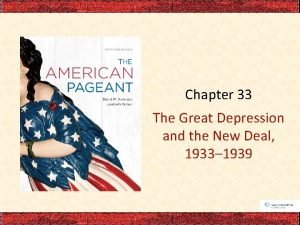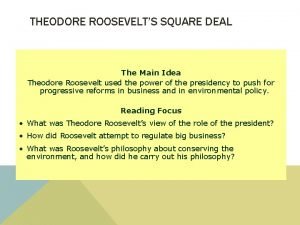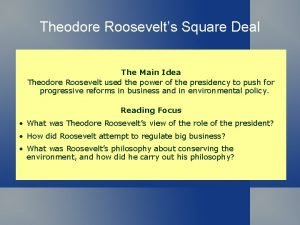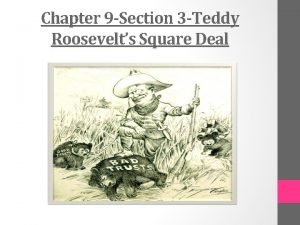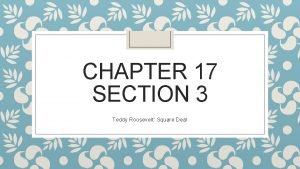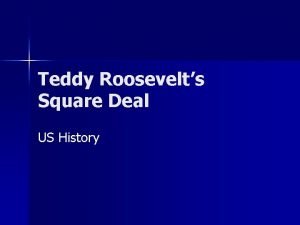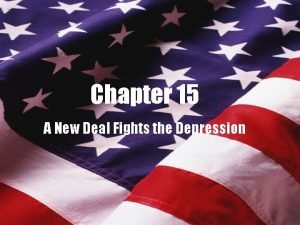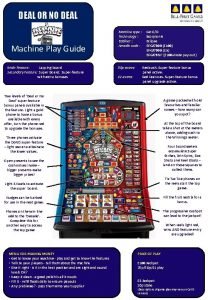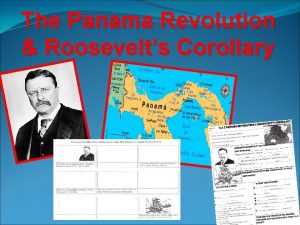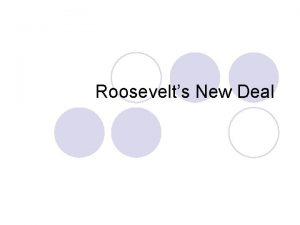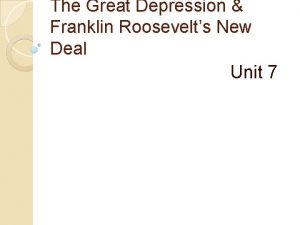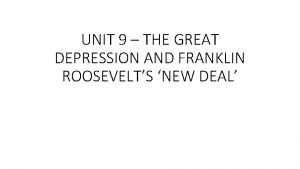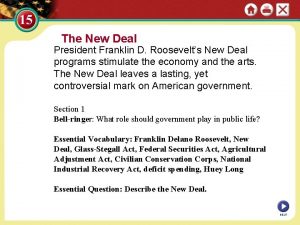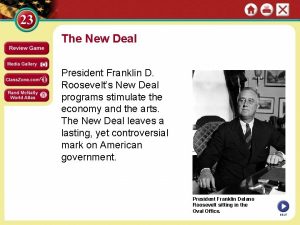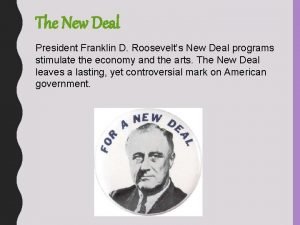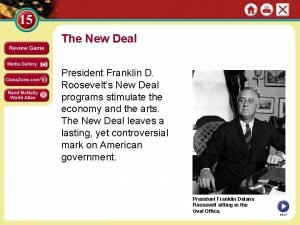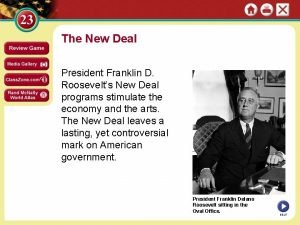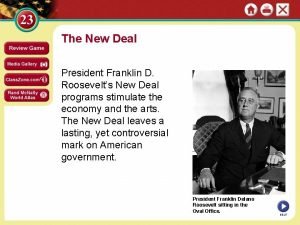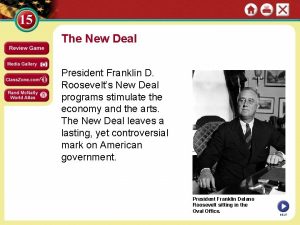The Great Depression Franklin Roosevelts New Deal Unit














- Slides: 14

The Great Depression & Franklin Roosevelt’s New Deal Unit 7

Chapter 31: The Causes and Responses to the Economic Collapse

Causes of The Great Depression -Overproduction Businesses produced too many goods, the prices went down -Underconsumption People were not buying as much, the businesses slowed down -Credit/Installment Payments People were paying for goods monthly instead of all at once. Businesses would not receiving full payments for years -Stock Market Crash 1929 Businesses began to slow and people sold their shares all at once. The market crashed. -Bank Failures

Agenda Class Discussion Bonus Army Different Ideas of how to fix the economy Hoover’s Response Roosevelt’s First 100 Days


Bonus Army Consisted of WWI Veterans who had fallen on hard times during the Great Depression. • Founder: Walter Waters • Started in Portland, Oregon, traveling east on board empty boxcars and cattle cars. By the time they reached Washington, D. C. , WWI veterans flocked to support their cause. • In 1924 Congress passed to a law for WWI veterans that included: each former soldier would be paid $1 for every day they had served during the war, plus an extra $. 25 for every day spent overseas. • – This bonus would not be paid until 1945. Goal of the Marchers: Convince Congress to pass a stipulation that would allow for half of their already promised bonus to paid in 1932 and the other half in 1945. • Results: President Hoover orders the Cavalry to fix bayonets and drove them out of Washington, D. C. •

Differences of Opinion As the depression grew deeper three main movements emerged to combat this epic situation. • The three main movements were Conservatives, Liberals, and Radicals. • Each had their own ideology: • – Ideology: is a set of basic ideas, beliefs, and values that form the basis of a social, economic, or political philosophy or program.

Conservative Response • • • Conservative: Is someone who cherishes and seeks to preserve traditional customs and values. Values in the 1930 s: Self-reliance, individual responsibility, and personal liberty. Opposed: Large governmental efforts to effect change. Strongly believed in laissez-faire government – government does not interfere with business; allow the invisible hand to work its magic. Believed in the business cycle – a pattern in which economic growth is followed by decline, panic, and finally recovery.

Liberal Response Liberal: Someone who is committed to the expansion of liberty and government. Government should play a role in regulating economic affairs. Wanted the government to expand its powers to protect individual liberty. Increase spending on public works – government – funded construction projects provide for such local needs as roads, bridges, and dams. Increase taxes on corporations and the wealthy to raise money for social welfare programs – provide aid to those in need. Government to work closely with businesses to aid in their recovery.

Radical Response • • • Radical: Someone who wants to make sweeping social, political, or economic changes in a society. Radicals seek change by democratic means or through revolution. Socialists and Communists are two branches of the radical movement. Communists wanted to replace capitalism with communism; where economic decisions would move out of the marketplace and into the hands of government planners. Wealth would be distributed to people according to their needs. Encouraged working – class citizens to rise up against the “greedy capitalists. ”

Midterm Shellacking and Change In 1930, Republicans lost 52 seats in the House and held on to the Senate by a single vote. • The new Congress had to make sure that banks could make loans to corporations so they could expand production and rehire workers. • Hoover asked Congress to establish the National Credit Corporation (NCC). – NCC created a pool of money to enable troubled banks to continue lending money in their communities. • Established because Federal Reserve refused Hoover’s request to put more currency into circulation. • Hoover requested that Congress set up the Reconstruction Finance Corporation (RFC). – RFC. would be used to make loans to banks, railroads, and agricultural institutions • By spring of 1932 the RFC had lent over $238 million to estimated 160 banks, 60 railroads, and 18 building and loan organizations. • Too overly cautious and failed to increase its loans in sufficient amount to meet the need. • Issue loans to states that no longer had enough resources to help the needy. •


Roosevelt’s New Deal First 100 Days While campaigning for the White House, Roosevelt promised a new deal for the American people. ” • This New Deal would do whatever was needed to help the needy and promote recovery. • His promises led to a blowout victory 472 – 59 in the Electoral College and over 7 million in the popular vote. •

Roosevelt’s First 100 Days • Emergency Banking Act gave the federal government broad power to help reopen the nation’s banks. • Beer-Wine Revenue Act legalized the sale of beer and wine • Reforestation Act established the Civilian Conservation Corps – provided work for 250, 000 men. • Federal Emergency Relief Act granted money to states for relief project to help unemployed. • Agricultural Adjustment Act set prices for farm crops while trying to reduce overproduction. • Tennessee Valley Authority funded construction of flood control dams and power plants in the Tennessee Valley States. • Federal Securities Act regulated the sale of stocks and bonds • Home Owners Refinancing Act provided aid to families in danger of losing their homes. • National Industrial Recovery Act established the Public Works Administration to supervise building projects and the National Recovery Administration to encourage fair business practices. • Banking Act of 1933 established the FDIC (Federal Deposit Insurance Corporation) to insure depositors from losses with banks failed.
 Tennessee valley authority new deal
Tennessee valley authority new deal What is the main idea of this cartoon?
What is the main idea of this cartoon? Chapter 33 the great depression and the new deal
Chapter 33 the great depression and the new deal Whats a square deal
Whats a square deal Whats the square deal
Whats the square deal Chapter 9 section 3 teddy roosevelts square deal
Chapter 9 section 3 teddy roosevelts square deal Chapter 9 section 3 teddy roosevelts square deal
Chapter 9 section 3 teddy roosevelts square deal Chapter 17 section 3 teddy roosevelts square deal
Chapter 17 section 3 teddy roosevelts square deal Roosevelts square deal
Roosevelts square deal A new deal fights the depression
A new deal fights the depression The new deal fights the depression
The new deal fights the depression A great deal vs a great many
A great deal vs a great many Deal or no deal machine
Deal or no deal machine Rudolf vizental
Rudolf vizental Spam
Spam


